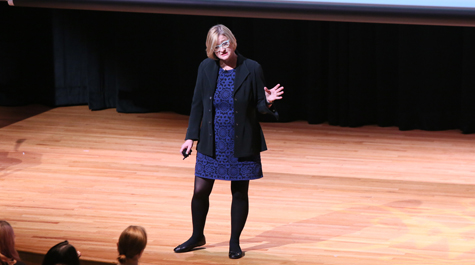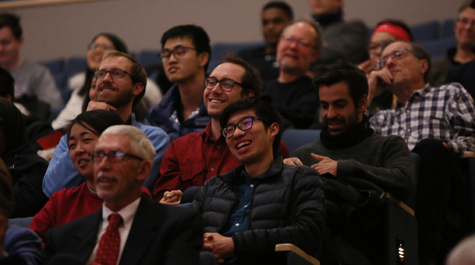Losh separates news from fake news
Fake news can be divided into three genres, Associate Professor of English and American Studies Elizabeth Losh told the audience attending her Tack Faculty Lecture on March 22.
But first she explained that the manner in which we consume news today is essential to the proliferation of something that has evolved from the advent of the printing press to radio and is now deeply a part of our current culture.
“We once consumed news through a morning daily newspaper then a nightly news broadcast before going to sleep,” she said. “During that intervening time, no news consumption took place. But with the rise of internet browsers and social network sites and news apps for smart phones, people are consuming news every hour, maybe every minute.”
{{youtube:medium|QENggXbPv-0,Fake news: Soccer, Trump and peanut-butter cups.}}
Initially launched in April 2012, the Tack Faculty Lecture was established through a generous commitment by Martha '78 and Carl Tack '78. The commitment creates an endowment for the series and speakers, who are William & Mary faculty members. The latest edition of the series was held at the Sadler Center’s Commonwealth Auditorium.
A playful fake news
Widespread use of the internet has led to the creation of three genres of fake news – 1.0, 2.0 and 3.0.“Fake news 1.0 would be satire that seems to make fun of the political theater,” she said. The Daily Show starring Jon Stewart ’84 was such a glowing example of this era that Stewart was once introduced as “the most trusted man in fake news.”
“But it didn’t undermine media literacy,” said Losh, quoting a 2007 Pew Center report that Daily Show and Colbert Report viewers were actually more likely to know elected representatives or members of the president’s cabinet than people who did not watch, or viewers of PBS.
However, as with all aspects of this seemingly increasingly complicated topic, there are exceptions. Losh pointed to a “story” in The Onion purporting that Congress would move out of Washington if a new capitol building weren’t constructed.
Absurd as it seems, the report was picked up and spread by some American news services. Social science researchers have been looking into why.
“An important factor seems to be that people care less and less about the source of online news and more and more on the content,” she said. “So it’s less about context and more about content for those consumers.”
That, she said, plays into fake news 2.0, which “lacks the jocularity of 1.0.”
The darker version
“It imagines a dark, paranoid world in which information is a weapon,” Losh said. “One needs to protect oneself by using information in this negative way.”Following the destruction of the World Trade Center in 2001, there was a spike in internet stories that were fake news. The film “Loose Change,” initially was released for free on the internet. It seems to be a documentary that raises questions about the Sept. 11 attack. It suggests, she said, that the World Trade Center was brought down by a controlled demolition. It argues that the people on the airplanes must have been actors because it would be impossible for people to use cell phones to communicate with loved ones from the air.
“It generally offers pieces of seeming evidence to sow doubt about the events of September 11,” she said. “It has been watched over one million times.”
But the rest of the story is this: The person who made the film, Dylan Avery, created it initially as fiction. The plot was intended to be that thieves use the terrorist attack as a distraction that would allow them to steal a large amount of gold.
{{youtube:medium|5QhwdeoNJms,Fake news: Radio, printing presses and the 'dystopian' future.}}
“But he thought it would be more convincing if he presented it as a documentary,” she said. “It proved so successful that multiple versions of it appeared, and some of them were produced by Alex Jones of ‘Info Wars,’ who then distributed it to his very large office.”
Jones, Losh said, maintains a philosophy that there is a “deep state” that is bent on taking away people’s weapons and wants to defang the Second Amendment as a way to put an authoritarian regime in charge.
Fake news 3.0 encompasses the modern situation where traditional news organizations are mistrusted and disparaged. The most obvious participant in this is President Donald Trump’s administration, and for Losh it took flight when Trump counselor Kellyanne Conway talked about “alternate facts.”
“I don’t want to demonize the Trump administration because it is not productive,” Losh said, “but it is important that there is confusion about what fake news is, that it’s being used to describe traditional news organizations. The grounds for truth when it comes to journalistic standards are no longer clear.
“News organizations issue corrections and retractions all of the time; you’d think that would make a news source more credible because they are doing their due diligence. And yet it gives people who doubt traditional journalism in the first place a cause to doubt it even more.”
Why policing fake news is difficult
Losh addressed some potential solutions put forth by social media companies, but also noted their obvious drawbacks. The biggest problem is that social network sites have no financial incentive to control fake news.“The profit model of a social network site depends on two things, targeted advertising and harvesting data,” Losh said. “Fake news stories give them more information that they can profit from than a real news story.
“At the same time, fact-checking sites are struggling financially. They have no profit model.”
The government can’t regulate fake news, she said, because the political parties are so polarized that any legislation one party introduces is shot down by the other.
European countries do a better job of introducing young people to news literacy curricula than the United States, but they have a different attitude about free speech and censorship.
The answer, if there is one, could be found in teaching the humanities because they are critical for identifying fake news, she said.
“It’s really useful to know something about history,” Losh said. “It’s really useful to know something about context, to know something about rhetoric, to know philosophy so that you can critically analyze arguments. And it’s useful to know foreign languages because many fake news stories travel because people do not speak the languages that are depicted in them.”

















